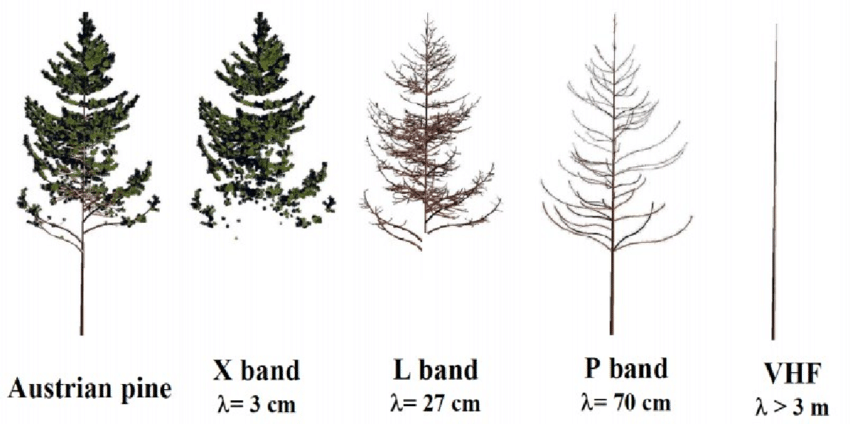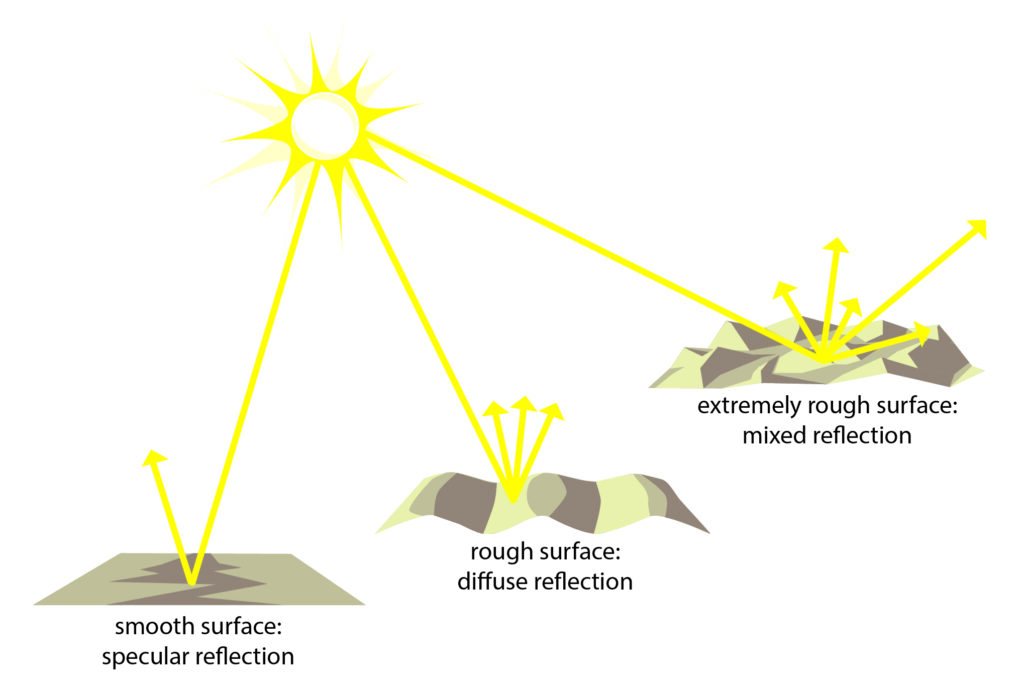On the Earth’s surface – Reflection and Absorbtion
LANDMOOC – Basics

Learning objectives of this topic
- How light travels
- Types of reflection
- Absorption & Albedo
- Real-life behavior
Paths of light
Reflection means that something is thrown back. If, for example, a ball is thrown against a wall, and it comes back, one could say that it has been reflected. The same happens with sunlight meeting the surface of the Earth: It is reflected and can thus be collected by a remote sensing sensor. If the light makes contact with a smooth surface, then the angle of incidence equals the angle of reflection.
If light makes contact with a body, it may not necessarily be reflected. It can pass through the body (transmission) or can be refracted (refraction). In case of refraction, the light passes through the body, but changes its propagation direction. However, the most important interactions regarding the principles of remote sensing are reflection and absorption.
Types of reflection
There are three types of light reflections. Note that the reflection depends on the surface roughness of an object.
- Specular (mirror-like) reflection: The light ray meets a smooth surface and the angle of incidence is identical with the angle of reflection.
- Diffuse reflection: The light ray meets a rough surface and is equally reflected in all directions.
- Mixed reflection: The light ray meets a very rough surface and is unequally reflected in all directions. This type of reflection is the most common one in nature!
Absorption and Albedo
Surfaces do not only reflect light; they also (partially) absorb it. In the process of absorption, energy is absorbed by the molecules of a given body and is then transformed into kinetic energy. The increased movement of the molecules produces heat, which is radiated to the surroundings.
The principles of absorption can be observed in daily life: A black t-shirt absorbs more sunlight than a white one. This is the reason we sweat more wearing a black shirt in summer. The albedo of a body is crucial for the percentage of sunlight it absorbs. Albedo measures the degree of reflection of materials in different spectral ranges. An albedo of 100% indicates that no absorption takes place; accordingly, an albedo of 0% indicates no reflection. The table on the right lists values of albedo for different materials in the visible range of light.
As shown in the animation from ESA below, you can see the varying surface reflectance, which is mainly caused by seasonal effects of disappearing snow cover.
| Material | Albedo |
|---|---|
| Snow | 80-90% |
| Cloud | 60-90% |
| Sand | 30% |
| Meadow | 20% |
| Forest | 5-18% |
| Concrete | 15% |
| Water (low angle) | 22% |
| Water (high angle) | 5% |
Behaviour of real-life ‘targets’
In a previous topic, we looked at how the Earth’s atmosphere impacts the radiation, and you also learned which kind of paths the light can take on its course. Now we will take a look at how the radiation interacts with objects or, as we say in a remote sensing perspective, ‘targets’, to better understand what is actually being interpreted in the imagery. As a general note, you should always keep in mind that the way, objects or “targets” reflect, or scatter electromagnetic radiation is always depending on the wavelength that is used. The figures below are simplified to give a sense of how different surfaces interact with EM radiation.
Paved and smooth surfaces
Built-up areas or paved roads are a good example of specular reflection behavior. Another example could be a still water surface or glass/metal objects. Seen as a smooth surface, this area will reflect most of the energy away from its illumination source with a reflection angle that is equal to the incidence angle.
Trees
With a “rougher” surface comes a more diverse reflection scheme. As a rule of thumb, diffuse reflection will dominate, if the wavelength is significantly smaller than the object it hits. As illustrated on the right, a tree is subject to different reflection processes. If microwaves of certain wavelengths (> 10 cm) hit it, they will mainly interact with the tree trunk, as the waves are too big to even recognize the leaves and smaller branches. However, the visible and near-infrared portion of the light spectrum heavily interact with the leaves as well.
Taking a closer look, we can also explain why leaves appear green to the human eye. Chlorophyll strongly absorbs EM radiation in the red and blue, but reflects the green wavelength. In remote sensing, near-infrared channels are well known for the potential to monitor plant vitality, because the cell structures of healthy vegetation are well-functioning diffuse reflectors.
While the figure above shows the behavior of EM radiation in the C-Band (6 cm wavelength), we have to keep in mind that this scheme will change for different wavelengths. As shown on the right, a tree, in this case pine, will look very different to different wavelengths.

Water bodies
Water absorbs mostly longer wavelengths and reflects the shorter ones. Therefore, water surfaces will, if they would not contain any organic matter, appear black (or at least very dark). However, the appearance of water surfaces/body strongly varies with the amount of particles that are present. A very sad but famous case illustrating changes in the reflection of a water body is the shrinking of the Aral Sea, located in Central Asia between Kazakhstan and Uzbekistan. When water levels were high, most of the short radiation was absorbed, but as the levels decreased and the water got more and more shallow, the reflection increased again (brightness increased). The greenish tone of the water originates from algae and the chlorophyll it contains.
Sources & further reading
Elachi, C. & van Zyl, J. (2015²). Introduction to the Physics and Techniques of Remote Sensing. Hoboken, USA: John Wiley & Sons, Inc.
European Space Agency (ESA, 2013). Earth’s Albedo. <https://www.esa.int/ESA_Multimedia/Videos/2013/08/Earth_s_albedo>.
Jensen, J.R. (2007²). Remote Sensing of the Environment. An Earth Resource Perspective. Upper Saddle River, USA: Pearson Prentice Hall.
National Aeronautics and Space Administration (NASA) Earth Observatory (EO, 2018). World of Change: Shrinking Aral Sea. <https://earthobservatory.nasa.gov/world-of-change/AralSea>.
Rees, W.G. (2010²). Physical Principles of Remote Sensing. Cambridge, USA: Cambridge University Press.
Schowengerdt, R.A. (2007³). Remote Sensing. Models and Methods for Image Processing. San Diego, USA: Academic Press.





